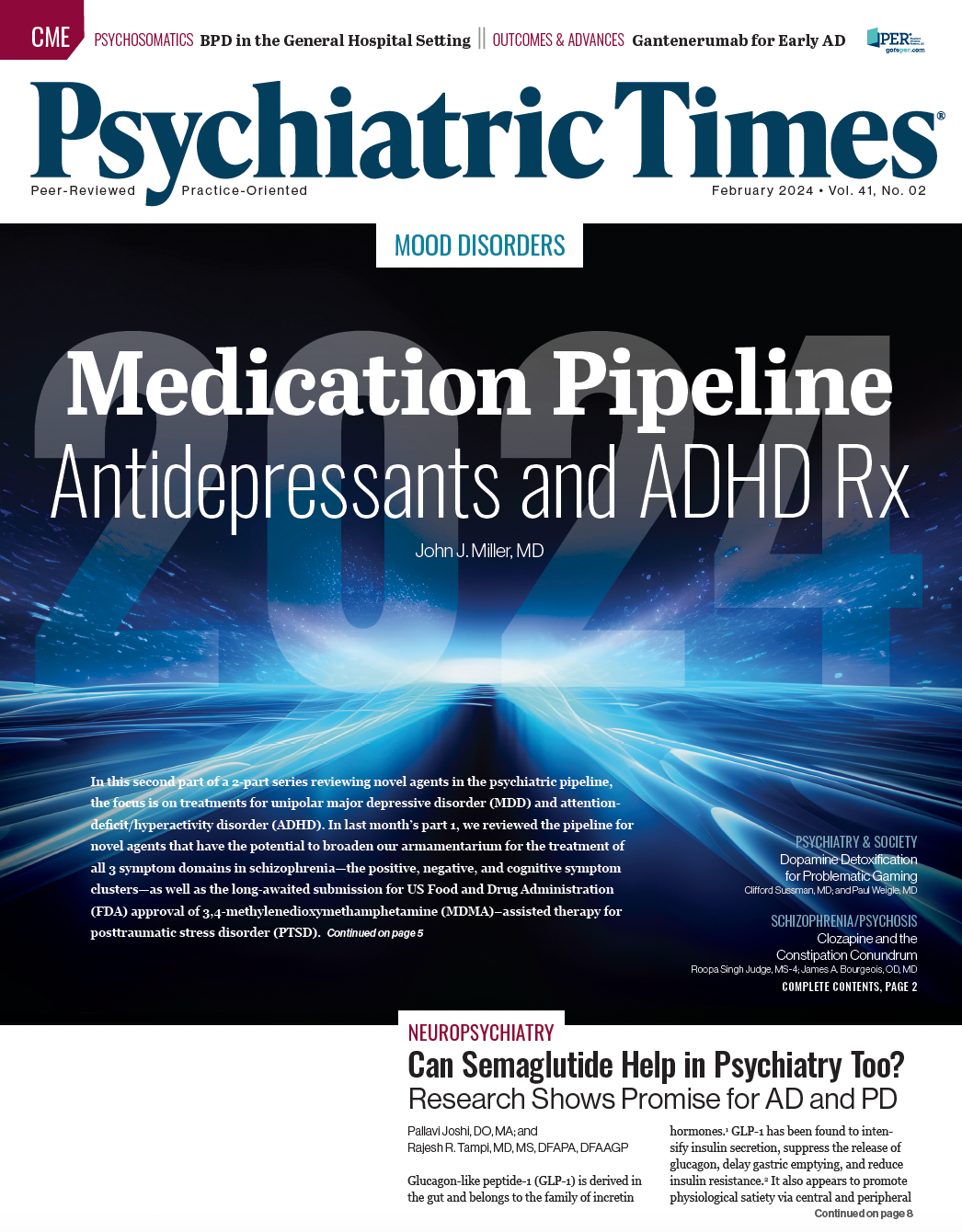News
Article
Psychiatric Times
Adding Insult to Narcissistic Injury: Comorbidity of Narcissistic Personality Disorder and Major Depressive Disorder
Diagnosing this intricate comorbidity demands a nuanced approach. Here's what you need to know.
Mary Long_AdobeStock

SPECIAL REPORT: PERSONALITY DISORDERS
The comorbidity of personality disorders and serious mental illnesses (SMIs) such as schizophrenia, major depressive disorder (MDD), and bipolar disorder is well documented. This literature primarily focuses on the comorbidity of borderline personality disorder (BPD) and MDD,1 BPD and bipolar disorder,2 and antisocial personality disorder and SMI in incarcerated populations.3 Much less attention has been paid to the comorbidity of narcissistic personality disorder (NPD) and SMI.4
NPD is a common condition, with prevalence estimates in clinical samples ranging from 1% to 17%.5 Individuals with NPD can experience significant impairments in psychosocial and interpersonal functioning.6,7 Despite its prevalence and consequences, NPD remains poorly understood. It is one of the least studied personality disorders, with no randomized control treatment studies.8,9
Diagnostic confusion also exists in clinical practice, as individuals with NPD may present in ways that are not adequately captured by the homogenous grandiose syndrome defined in DSM-5.7 Classically, a dichotomy is drawn between a grandiose type and a fragile type.7,10* A third, high-functioning or exhibitionist, type has also been described.8
Although individuals with NPD do not typically seek psychiatric care, the condition is highly comorbid with other psychiatric disorders that often do bring patients to clinical attention.11 While grandiose narcissism is linked with substance use and other personality disorders, fragile narcissism is often comorbid with MDD, anxiety, self-injury, and suicide.8
One study found that in a sample of patients with NPD, one-third had comorbid MDD, with that figure rising to 57% among individuals with fragile narcissism.8 Other studies have found associations between narcissism and depressive symptoms,12 as well as between fragile narcissism and depressive temperament.13 MDD is a debilitating condition that causes significant disability and carries a suicide risk of approximately 15%, making the occurrence of MDD in NPD of significant clinical concern.14
A case of a major depressive episode with suicidal ideation in a middle-aged man with fragile narcissism is now presented. The goal is to offer insights for accurately diagnosing and effectively managing inpatients with these comorbid diagnoses, which demand a specialized and individualized approach.
Case Study
“Jeffrey” is a 52-year-old single man who lives in New York, New York, and formerly worked as a successful literary agent. He has a history of treatment-refractory MDD and generalized anxiety disorder, with numerous failed medication trials and several psychiatric hospitalizations. He presented to the emergency department (ED) at the encouragement of his psychiatrist for worsening functioning, depression, and suicidal ideation after losing his job and partner.
In the ED, Jeffrey reported a long-standing history of depression and anxiety that had been well controlled without psychiatric care. He had maintained a successful career as a literary agent for more than 20 years as well as a 15-year relationship with his partner. His mental health gradually deteriorated during the COVID-19 pandemic as he struggled to adapt to remote work and experienced difficulties using unfamiliar technologies.
He compared himself with younger colleagues who were better able to adapt to the technological changes. He developed feelings of inadequacy and poor self-esteem regarding his performance at work, which also contributed to worsening depression and anxiety.
This was when he first sought outpatient psychiatric care. He moved from one psychiatrist to another, often becoming disappointed and “losing faith” in them when his symptoms worsened. He had a string of hospitalizations, each resulting in partial recovery.
(Medical records revealed that Jeffrey was trialed on 5 selective serotonin reuptake inhibitors [SSRIs], 1 serotonin-norepinephrine reuptake inhibitor, 2 atypical antidepressants, 2 tricyclics, 2 monoamine oxidase inhibitors, 3 mood stabilizers, 5 neuroleptics, ketamine, and electroconvulsive therapy, all with minimal effect.)
Jeffrey recounted that his treatment teams “did nothing” for him and “had no idea what to do” with him.
His occupational and social functioning continued to deteriorate, and he ultimately lost both his job and his relationship in 2021. These events further worsened his depression, anxiety, and hopelessness, and he developed suicidal ideation with a plan. Jeffrey was then admitted involuntarily due to his risk of harm to self.
On admission, Jeffrey was started on pramipexole and desipramine. Psychotherapy initially focused on his perception of his technological inadequacy and his frustration and hopelessness as he tried to find a job. Cognitive behavioral approaches were used, including cognitive restructuring and exposure to new technologies.
Although treatment initially resulted in a brighter affect and the reduction of his suicidal ideation, Jeffrey still reported a sad mood most days. He frequently asked to speak with his team after sessions, fixated on medication doses and adverse effects, and demanded daily that his regimen be changed.
When speaking with his mother, he expressed deep hopelessness, frustration with his care, and feeling misunderstood by his team. Tranylcypromine was trialed, and although Jeffrey felt more energetic, his mood and anxiety did not improve.
Over time, it became clear that much of Jeffrey’s anxiety stemmed from his unrealistic expectations about how quickly his mood would improve and how easy it would be to find a job. He revealed his belief that he would be able to quickly start his own literary agency and ultimately become a member of elite New York City social clubs.
Jeffrey expressed views of past colleagues that oscillated between envy of their technological knowhow, criticism of their inability to “read people” as well as he could, and resentment of their unwillingness to recognize this unique ability in him. In contrast, he described his ex-partner as an “angel” who was supportive of his endeavors and bemoaned never being able to find another person like them.
Nonetheless, Jeffrey’s affect dramatically improved over the course of admission, with continued resolution of his sleep disturbance, fatigue, concentration, and suicidality, although with persistent depressed mood, hopelessness, and anxiety. He was ultimately discharged to a Personalized Recovery Oriented Services program. Despite his frequent attendance at his program, his depression relapsed relatively rapidly, resulting in another hospitalization.
Discussion
Jeffrey in many ways personifies the fragile narcissist. At baseline, he struggles with feelings of inferiority, self-doubt, and hypersensitivity. This is consistent with work that indicates that fragile narcissists have depressive tendencies with respect to self-definition and self-criticism, which can predispose them to depressive episodes.15
Jeffrey’s sense of inadequacy stems from a fragile sense of self that hinges on maintaining a self-image of being special (eg, having unique interpersonal abilities, having special talents at work, and being unconditionally admired in personal relationships). His grandiosity and fantasies of unlimited success can be seen as defenses that served to protect this vulnerable self-image.8,16
The stressors of Jeffrey’s job loss and breakup inflict narcissistic injuries—perceived threats to his self-esteem and profound disappointments—that overwhelm these narcissistic defenses, sending Jeffrey into a spiral of withdrawal, self-accusation, and depression.8,17,18 He feels profoundly embarrassed, envious of others, misunderstood, mistreated, and powerless.
Even the dependent features of his character structure, such as an overreliance on his treatment team and needs for constant reassurance from his mother, reflect a pattern of self-doubt and are consistent with the literature on the comorbidity of fragile narcissism and dependent personality disorder.8 His rapid affective changes reflect responses to treatment as well as vacillations in his self-esteem.
Psychopharmacologic interventions are partially helpful in managing some of Jeffrey’s depressive symptoms (sleep disturbance, decreased energy, and poor concentration), but they fail to sufficiently treat the guilt, worthlessness, social withdrawal, and depressed mood that may be more closely tied with his underlying personality dysfunction. Even still, Jeffrey’s psychopharmacologic trials are rarely adequate, given his fixations on adverse effects and demands from his providers.
His care is highly fragmented as he seeks new treatment teams, often oscillating between overdependence and devaluation. Jeffrey is therefore unable to engage in what may be the most effective treatment for him: a consistent psychopharmacologic regimen targeting specific symptoms in combination with longitudinal evidence-based psychotherapy—ultimately resulting in a debilitating illness course.
Clinical Challenges
As illustrated in the case, there exist significant challenges when diagnosing major depression in individuals with NPD. There is considerable overlap in the symptoms of MDD and fragile narcissism, making it difficult to attribute symptoms specifically to a mood disorder or an expression of character pathology.
Treating major depressive episodes in patients with NPD can also pose unique therapeutic hurdles. It is common practice for clinicians to treat depression in individuals with NPD with first-line antidepressants such as SSRIs, although there is little empiric evidence for the use of medications for NPD itself.4
Psychotherapy is also not without its challenges. The exaggerated self-esteem of patients with NPD may make it difficult for them to recognize problems as such and engage in treatment.7 The countertransference often experienced by practitioners (feeling coerced to find a panacea or feeling disparaged or incompetent) can further complicate the formation of a therapeutic alliance.19
Although treatment guidelines are scant, many of the recommended therapeutic approaches—mentalization-based therapy, transference-focused psychotherapy, schema-focused psychotherapy, and dialectical behavioral therapy—are adapted from the treatment of BPD.4,7
They all, however, require longitudinal relationships between the patient and the therapist, making them impractical in the acute care setting. It is no surprise, then, that in individuals presenting with a major depressive episode, comorbid NPD is associated with a slower and less significant recovery.20
Diagnosis and Management
Diagnosis
Given the difficulty in distinguishing depressive symptoms from symptoms arising from NPD, a variety of diagnostic approaches may be useful in assessing the comorbidity of MDD and NPD. As with all patients, it is critical to examine aspects of the patient’s inner experience, as well as patterns of interpersonal functioning, to assess for the presence of a personality disorder and inform a robust biopsychosocial formulation.
If NPD is suspected, clinicians should look for traits consistent with both grandiose and fragile narcissism. The use of semistructured interviews may aid in comprehensively evaluating for symptoms of both depression and personality disorders using DSM-5 diagnostic criteria.21†
However, current DSM-5 criteria for NPD are limited in their breadth, heavily relying upon grandiosity and externally conspicuous behavior, and thus may fail to identify patients with fragile narcissism.
Some advocate for the use of the Alternative DSM-5 Model for Personality Disorders, a diagnostic approach to personality disorders developed by the DSM-5 Personality and Personality Disorders Work Group, which delineates between normal and disordered personality and captures clinical heterogeneity and range of presentation.21 Once the presence of NPD is established, providing psychoeducation may set the stage for collaborative goal setting.7
Psychopharmacology
Once the diagnosis of MDD is established, the guidelines for standard treatments for MDD should be followed. It is useful to anticipate that comorbid NPD may increase the likelihood of patient dropout or incomplete treatment response.7
Psychotherapy
Ideally, long-term, evidence-based treatments are provided.4,7 However, even in acute care settings, general therapeutic principles can be useful, including nonjudgmental, curious interventions that use the patient’s own words and recognize their vulnerability, ultimately challenging their self-criticism and encouraging interpersonal connections. Therapy should also set clear and achievable goals that are periodically reviewed with the patient.
Concluding Thoughts
NPD and MDD are 2 common, and commonly comorbid, disorders. When they co-occur, the level of distress and dysfunction experienced can be significant. Thus, even though individuals with NPD do not often present for care, the occurrence of a depressive episode may bring them to clinical attention, necessitating diagnosis and appropriate treatment of both conditions.
Diagnosing this intricate comorbidity demands a nuanced approach. Thoughtful interviews should seek to understand the patient’s personality structure, and integrating semistructured interviews and alternative diagnostic models can better capture the diverse spectrum of narcissistic presentations, including its 3 subtypes.
For treatment, the use of standard MDD treatments in combination with tailored, patient-centered psychotherapy can offer utility, even in acute care settings. Thus, although the co-occurrence of NPD and MDD may add insult to injury for patients and compound challenges for clinicians, appropriately recognizing and addressing both may soften the blow.
*The grandiose type is also known as “malignant” or “overt” and is defined as “grandiose, arrogant, entitled, exploitative, and envious.” The fragile type is also referred to as “vulnerable” or “covert” and is defined as “overly self-inhibited and modest but harboring underlying grandiose expectations for oneself and others.”7,10
†Examples of the latter include the Structured Clinical Interview for DSM-5 Personality Disorders, Personality Inventory for DSM-5, and the DSM-5 Level of Personality Functioning Scale.
Dr Green (PGY-2) is a resident in the Department of Psychiatry at Columbia University Irving Medical Center, New York State Psychiatric Institute. Dr Holderness is an associate clinical professor of psychiatry at the Columbia University Vagelos College of Physicians and Surgeons, New York State Psychiatric Institute.
References
1. Gunderson JG, Stout RL, Sanislow CA, et al. New episodes and new onsets of major depression in borderline and other personality disorders. J Affect Disord. 2008;111(1):40-45.
2. Fornaro M, Orsolini L, Marini S, et al. The prevalence and predictors of bipolar and borderline personality disorders comorbidity: systematic review and meta-analysis. J Affect Disord. 2016;195:105-118.
3. Glenn AL, Johnson AK, Raine A. Antisocial personality disorder: a current review. Curr Psychiatry Rep. 2013;15(12):427.
4. Voytenko VL, Huprich SK. Managing treatment-resistant depression with comorbid personality disorders. In: Quevedo J, Riva-Posse P, Bobo WV, eds. Managing Treatment-Resistant Depression: Road to Novel Therapeutics. Academic Press; 2022:441-459.
5. Ronningstam E. Narcissistic personality disorder: facing DSM-V. Psychiatr Ann. 2009;39(3):111-121.
6. Miller JD, Widiger TA, Campbell WK. Narcissistic personality disorder and the DSM-V. J Abnorm Psychol. 2010;119(4):640-649.
7. Caligor E, Levy KN, Yeomans FE. Narcissistic personality disorder: diagnostic and clinical challenges. Am J Psychiatry. 2015;172(5):415-422.
8. Russ E, Shedler J, Bradley R, Westen D. Refining the construct of narcissistic personality disorder: diagnostic criteria and subtypes. Am J Psychiatry. 2008;165(11):1473-1481.
9. Levy KN, Chauhan P, Clarkin JF, et al. Narcissistic pathology: empirical approaches. Psychiatr Ann. 2009;39(4).
10. Dickinson KA, Pincus AL. Interpersonal analysis of grandiose and vulnerable narcissism. J Personal Disord. 2003;17:188-207.
11. Stinson FS, Dawson DA, Goldstein RB, et al. Prevalence, correlates, disability, and comorbidity of DSM-IV narcissistic personality disorder: results from the wave 2 national epidemiologic survey on alcohol and related conditions. J Clin Psychiatry. 2008;69(7):1033-1045.
12. Dawood S, Pincus AL. Pathological narcissism and the severity, variability, and instability of depressive symptoms. Personal Disord. 2018;9(2):144-154.
13. Tritt SM, Ryder AG, Ring AJ, Pincus AL. Pathological narcissism and the depressive temperament. J Affect Disord. 2010;122(3):280-284.
14. Angst J, Angst F, Stassen HH. Suicide risk in patients with major depressive disorder. J Clin Psychiatry. 1999;60(suppl 2):57-62.
15. Kealy D, Tsai M, Ogrodniczuk JS. Depressive tendencies and pathological narcissism among psychiatric outpatients. Psychiatry Res. 2012;196(1):157-159.
16. Miller A. Depression and grandiosity as related forms of narcissistic disturbance. Int Rev Psychoanal. 1979;6(1):61-76.
17. Freud S. Mourning and melancholia. In: 1914-1916: On the History of the Psycho-Analytic Movement, Papers on Metapsychology and Other Works. Hogarth Press; 1917:237-258. Strachey J, ed. The Standard Edition of the Complete Psychological Works of Sigmund Freud; vol 14.
18. Goldberg A. Psychotherapy of narcissistic injuries. Arch Gen Psychiatry. 1973;28(5):722-726.
19. Gabbard GO. Transference and countertransference: developments in the treatment of narcissistic personality disorder. Psychiatr Ann. 2009;39(3):129-136.
20. Ellison WD, Levy KN, Cain NM, et al. The impact of pathological narcissism on psychotherapy utilization, initial symptom severity, and early-treatment symptom change: a naturalistic investigation. J Pers Assess. 2013;95(3):291-300.
21. Samuel DB, Griffin SA. A critical evaluation of retaining personality categories and types. In: Huprich SK, ed. Personality Disorders: Toward Theoretical and Empirical Integration in Diagnosis and Assessment. American Psychological Association; 2015:43-62.

Newsletter
Receive trusted psychiatric news, expert analysis, and clinical insights — subscribe today to support your practice and your patients.






